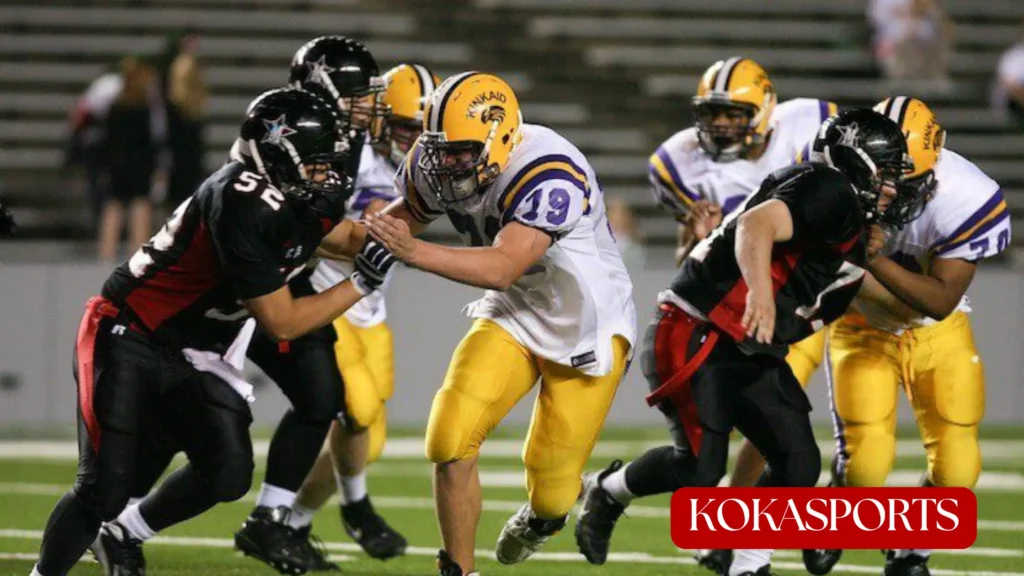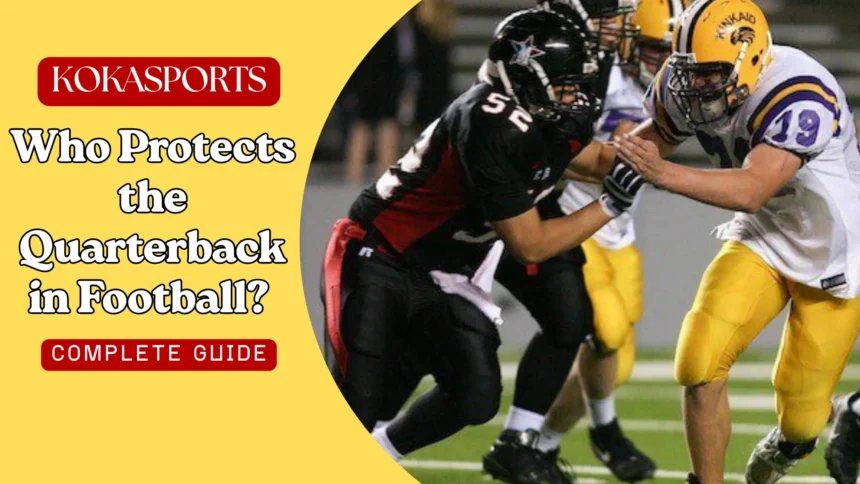When you watch a football game, the quarterback stands at the center of attention. This player throws passes, makes crucial decisions, and often determines whether a team wins or loses. But here’s something many fans don’t realize: the quarterback cannot succeed alone. Behind every great QB stands a group of dedicated players whose main job is to protect the quarterback from aggressive defenders trying to tackle him. This guide explains exactly who protects the quarterback in football and how different positions in football work together to keep the most important offensive player safe.
The Quarterback’s Central Role

The quarterback serves as the leader of the offense in American football. This position requires someone who can read defenses, throw accurate passes, and make split-second decisions under pressure. The QB touches the ball on nearly every offensive play, receiving the ball from the center at the start of each play. Whether the team runs or passes, the quarterback must be able to execute the play successfully.
When defenses send players rushing toward the QB, trying to tackle the quarterback before he can throw, the risk of injury increases dramatically. A sacked quarterback means lost yardage. An injured quarterback can end a season. This is why protecting the signal-caller is absolutely essential for any football team hoping to score points and win games.
Great quarterbacks throughout history have always had strong protection. They needed teammates who could block aggressive defenders and give them enough time to find open receivers downfield. Without this protection, even the most talented QB struggles to succeed.
Read More: What Is a Dig Route in Football? Complete Guide to the Route Tree & Receiver Routes
The Offensive Line: The First Line of Defense
The offensive line represents the first line of defense for any quarterback. These five powerful linemen form a wall between the QB and the defensive line. The offensive lineman who plays in this unit must possess incredible strength, quick footwork, and excellent technique to succeed.
The Five Key Positions on the Offensive Line
The offensive line consists of five crucial positions on the offensive line that work as a coordinated unit:
The Center snaps the ball to the quarterback and coordinates all blocking assignments. This player lines up in the middle and communicates with teammates on either side of the center. The center must recognize defensive formations and call out protections before each snap. After delivering the ball, the center immediately engages defensive linemen trying to push through the middle.
The Two Guards play on the left and right side of the center. These interior blockers provide pocket stability and prevent inside pressure from defensive tackles and defensive ends. Guards must be powerful enough to handle bull rushes from massive defensive tackles while maintaining proper footwork to adjust to defensive stunts and twists.
The Left Tackle has earned a reputation as one of the most important position roles in football. For a right-handed quarterback, this player protects the quarterback’s blind side – the area the QB cannot see while looking downfield. The left tackle faces the defense’s best pass rusher and must possess elite athleticism, length, and technique. Famous left tackles have commanded huge salaries because they keep franchise quarterbacks healthy and upright.
The Right Tackle handles the opposite edge, providing crucial protection on passing plays while also excelling in run plays. Though sometimes considered less prestigious than the left tackle spot, the right tackle faces formidable pass rushers and must execute both pass protection and run blocking at a high level.
These five players who line up on the line of scrimmage work together using various blocking schemes. They communicate constantly, identifying which defender each will block. On pass play situations, they create a protective pocket around the quarterback. On run plays, they open holes for the running back to explode through.
| Position | Primary Role | Key Skills Required |
|---|---|---|
| Center | Snap ball, coordinate blocking | Communication, awareness, strength |
| Left Guard | Interior pass/run blocking | Power, quick hands, agility |
| Right Guard | Interior pass/run blocking | Strength, footwork, technique |
| Left Tackle | Blind side protection | Elite athleticism, length, balance |
| Right Tackle | Edge protection/run blocking | Versatility, strength, technique |
How Offensive Linemen Block
Pass blocking requires offensive tackle players and guards to use specific techniques. They must maintain a solid base with proper foot positioning, keep their hands inside the defender’s frame, and move their feet quickly to mirror the pass rusher’s movements. The pocket created by the five-man wall gives the quarterback precious seconds to scan the field and deliver accurate passes.
Run blocking uses different techniques. Offensive linemen might use drive blocking to push defensive linemen backward, or pull from their position to lead block on sweeps. Zone blocking schemes assign each blocker a specific area rather than a specific defender. These varied approaches keep defenses guessing and create running lanes for the ball carrier.
Running Backs and Their Protection Role

The running back position handles multiple responsibilities. While most fans think of running backs primarily as ball carrier options who gain yards on run plays, these versatile players on the field also serve crucial blocking roles.
When defenses send extra rushers in a blitz, running backs must identify threats quickly and step up to block incoming linebackers or defensive back players. Elite pass-blocking running backs study film extensively to recognize blitz patterns. They must possess courage to confront defenders much larger than themselves, along with proper technique to redirect their momentum.
Some of the best running backs in football history excelled at pass protection. They understood that keeping their quarterback clean was just as valuable as gaining rushing yards. On certain plays, the running back stays in the backfield specifically to provide extra protection rather than running a route. This decision often determines whether a quarterback can complete a deep pass or gets sacked for a significant loss.
Tight Ends as Dual-Threat Protectors
The tight end position combines blocking ability with receiving skills. These players who line up either on the line of scrimmage next to an offensive tackle or slightly behind serve as the last line of defense on the edge. When aligned on the line, tight ends help tackle edge rushers working around the offensive tackle.
On pass plays, the tight end might chip block a defensive end before releasing into a route. This momentary contact delays the pass rusher just enough for the quarterback to complete a quick throw. Other times, the tight end stays in to provide maximum protection, creating a six-man blocking front that gives the QB extra time for deep routes to develop.
Great tight ends must be able to transition seamlessly between blocking and receiving. They read defenses pre-snap, understand their assignment, and execute it with precision. When a tight end excels at both blocking and catching passes, the offense becomes incredibly difficult to defend because defenses cannot predict whether he will block or run a route.
Wide Receivers and Indirect Protection
Wide receiver players might not block defenders directly near the quarterback on most plays, but they contribute to QB protection in important ways. By running precise routes and getting open quickly, receivers give the quarterback fast options to get rid of the ball. Quick slants, screens, and hitches function as extended handoffs, preventing defenders from generating pressure.
Wide receivers also help by creating space. When receivers command attention from defensive back coverage, fewer defenders can blitz. The threat of big plays downfield forces safeties to play deeper, opening up short and intermediate routes that allow the quarterback to release the ball quickly before pressure arrives.
Defensive Positions That Threaten the Quarterback
To appreciate who protects the quarterback, you must identify which defensive positions in American football create danger. The defensive line includes defensive tackles and defensive ends whose primary goal is to rush the quarterback. These four players use speed, power, and technique to beat offensive linemen and sack the quarterback.
Defensive end players line up at the end of the defensive line and attack the edges, trying to get around tackles. Defensive tackle players push through the interior, battling guards and centers. Both positions create havoc when offensive blockers fail to maintain proper technique.
Linebackers represent another major threat. The middle linebacker often leads the defense in tackles and can blitz through gaps. Outside linebackers might rush from the edge like defensive ends or drop into coverage. When linebacker blitzes occur, running backs and tight ends become critical to picking up these extra rushers.
Even defensive backs get involved. Strong safeties might blitz more frequently than free safeties, attacking from unexpected angles. These players on the defense force offenses to identify and account for every potential rusher. When a defensive player comes free on a blitz, disaster usually follows.
Strategic Protection Schemes
Football teams use various formations and schemes to enhance protection. Max protection formations keep seven or eight players who line up behind the line or on the edges specifically to block for the quarterback. These formations sacrifice potential receivers to ensure maximum safety for the signal-caller.
Slide protection assigns each offensive lineman responsibility for a specific gap or direction. The entire line slides one direction, with the running back or tight end responsible for the opposite side. This coordinated movement helps handle twists and stunts where defensive linemen cross paths to confuse blockers.
Quick-passing concepts serve as another form of protection. Three-step drops and fast-developing routes get the ball out of the quarterback’s hands in under two seconds, neutralizing even the best pass rush. These plays essentially replace traditional protection with timing and accuracy.
The Evolution of Quarterback Protection
The NFL and other leagues have implemented numerous rules to protect the quarterback from dangerous hits. Roughing the passer penalties punish defenders who hit the QB late or target vulnerable areas. These rules recognize that quarterbacks are critical players on a team whose safety impacts competitive balance.
Modern training methods have revolutionized offensive line play. Teams study film extensively, breaking down defensive tendencies and identifying weaknesses. Analytics help teams understand which blocking schemes work best against specific defensive fronts. The chemistry developed through countless practice repetitions allows 11 players on the field to operate as one cohesive unit.
Special Teams and Rare Protection Scenarios
While special teams units typically focus on kicks, punts, and returns, they occasionally involve quarterback protection. On fake field goal attempts, the holder (often a backup QB) needs protection to throw. Teams must provide adequate defense for the punter or holder on such trick plays, even though these situations arise infrequently.
Key Positions Working Together
The table below summarizes how different positions contribute to protecting the quarterback:
| Position Group | Primary Protection Method | When Most Critical |
|---|---|---|
| Offensive Line | Direct blocking on line of scrimmage | Every pass play |
| Running Backs | Blitz pickup, inside protection | Third down, obvious passing situations |
| Tight Ends | Edge blocking, chip blocks | Against elite pass rushers |
| Wide Receivers | Quick routes, spacing | All passing situations |
Conclusion:
After examining American football positions in detail, one truth emerges: protecting the quarterback requires coordinated effort from multiple offensive player positions. The offensive line provides the first line of defense against pass rushers. Running backs pick up blitzing linebackers, tight ends offer edge protection, and wide receiver players contribute through precise route running.
The next time you watch a quarterback deliver a perfect touchdown pass, remember the unsung heroes making that moment possible. These dedicated blockers sacrifice their bodies behind the defensive line to give their leader of the offense time to succeed. The 11 players working together, each fulfilling their American football positions assignment, demonstrate football’s beautiful complexity. From the middle of the defensive pressure to successful completions where receivers on every play get open, catch passes from the quarterback, and move the ball downfield – it all starts with protection. That’s why certain positions dedicated to blocking receive such respect and why protecting the QB remains football’s most critical collective responsibility.
FAQs
Who protects the quarterback in a football game?
The offensive line, especially the tackles, guards, and center, protects the quarterback by blocking defenders.
Which players have the responsibility to protect the quarterback?
Mainly the offensive linemen the left tackle, right tackle, guards, and center along with help from running backs and tight ends in certain plays.
Who protects the QB’s blind side?
The left tackle protects the quarterback’s blind side (for right-handed QBs); for left-handed QBs, it’s the right tackle.



